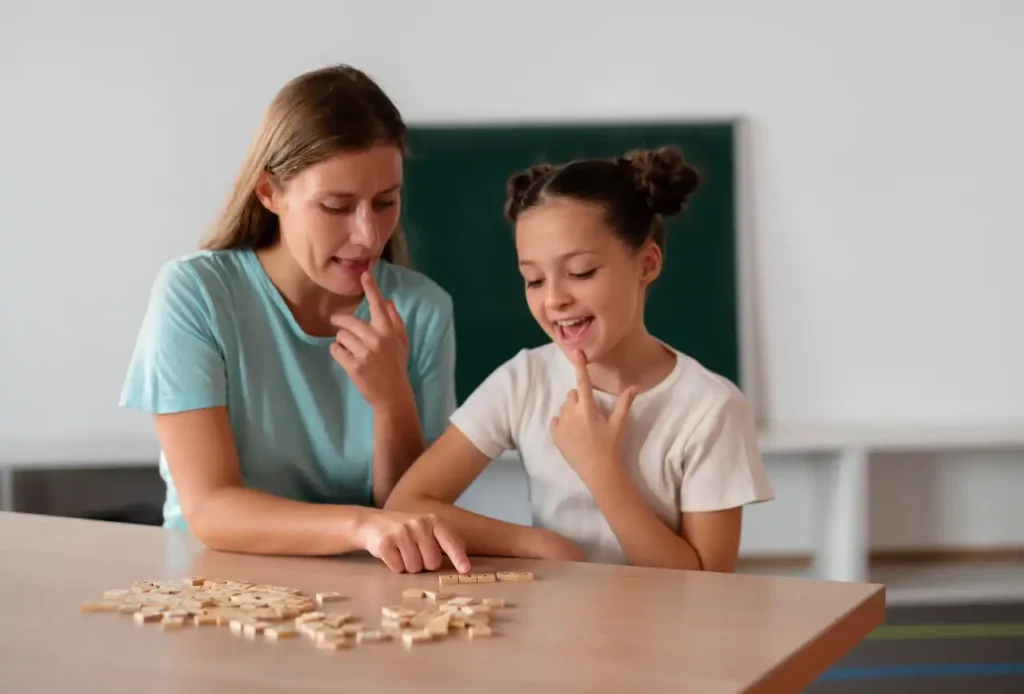If your child stutters and is struggling with day-to-day communication, the worries and concerns for your child are very real. You’re not alone. According to the National Institute on Deafness and Other Communication Disorders, approximately 5% of children experience stuttering at some point, with most cases beginning between ages 2 and 6.
It’s important to understand the natural course of stuttering:
- Around 75-80% of children recover naturally (called spontaneous recovery), often within the first 1-2 years after onset
- About 20-25% develop persistent stuttering, meaning it continues beyond early childhood and can last into adolescence or adulthood without intervention
The exercises and strategies in this guide can support your child’s communication development, whether they’re likely to recover naturally or may need ongoing support.
This comprehensive guide presents 15 evidence-based exercises that speech-language pathologists recommend for helping children who stutter, along with practical tips for making practice fun and effective at home.
Understanding Stuttering in Children: What Parents Need to Know
Before diving into exercises, it’s crucial to understand that stuttering is a neurological condition affecting speech fluency. It’s not caused by anxiety, shyness, or poor parenting. Children who stutter know exactly what they want to say—their brain simply processes speech differently.
Stuttering typically manifests as:
- Repetitions: “I-I-I want that”
- Prolongations: “Ssssssee the dog”
- Blocks: Complete stops in speech flow
- Secondary behaviors: Eye blinking, facial tension, or avoiding certain words
Early intervention through targeted exercises can make a tremendous difference in your child’s communication confidence and fluency development.

The Foundation: Creating a Supportive Practice Environment
Success with stuttering exercises begins with the right environment. Children need to feel safe, supported, and free from pressure when practicing speech techniques. Here’s how to set the stage:
- Establish a “practice time” routine: Dedicate 10–15 minutes daily to speech exercises, preferably at the same time each day. Consistency matters more than duration. It’s also much better to practice every day for 10–15 minutes instead of one time per week for 70–90 minutes. Intensity and consistency are key to making neuroplastic changes stick.
- Make it playful: Frame exercises as games rather than “homework.” Children learn best through play, and reducing pressure actually improves fluency outcomes.
- Model patience: Maintain eye contact, don’t finish your child’s sentences, and show through your body language that you have time to listen.
- Celebrate effort, not perfection: Praise your child for trying techniques, not just for fluent speech. Building confidence is as important as building skills.
15 Proven Exercises to Help Your Stuttering Child
1. Easy Onset Breathing Technique
This foundational exercise teaches children to start sounds gently, reducing the tension that often triggers stuttering blocks.
How to practice:
- Have your child take a relaxed breath before speaking.
- Start the first sound of a word very softly, like turning up the volume slowly.
- Gradually increase to normal speaking volume.
- Practice with single words first, then phrases.
Make it fun: Pretend to be a balloon slowly inflating, or a flower opening in the morning sun.
2. Slow and Smooth Speech (Turtle Talk) — A Core Fluency Shaping Practice
Speaking at a slower rate gives the brain more time to coordinate the complex movements required for speech. This technique is fundamental to fluency-shaping therapy and helps children develop awareness of speech control.
How to practice:
- Model speaking in slow, stretched-out speech.
- Have your child imitate, stretching each word like taffy.
- Start with single words; progress to sentences.
- Begin with 20-minute practice sessions to properly establish the technique.
- Ask your child: “Do you feel like you’re in control?” This awareness is crucial.
- Don’t worry if it doesn’t sound natural at first.
Important understanding: Speaking slowly isn’t the end goal—it’s a practice tool that helps children recognize when they are in control of their speech versus when they’re not. This awareness becomes the foundation for managing stuttering moments.
Game idea: Create a “Turtle Talk Time” where everyone in the family practices slow, controlled speech together for 20 minutes. Make it funny and enjoyable rather than forced.
3. Light Contact Technique

Many stuttering moments involve too much pressure in the mouth. This exercise teaches gentle articulation.
How to practice:
- Practice words using feather-light contact.
- Progress from single words, preferably ones that start with vowels or “Wh-” questions to start a conversation.
Activity suggestion: Use bubbles—the gentle breath needed mirrors the light contact concept.
4. Pausing and Phrasing Practice
Strategic pauses reduce speech rate and provide natural breaks for breath and planning.
How to practice:
- Read sentences with your child, pausing at commas and periods.
- Count to two during each pause.
- Practice breaking longer sentences into smaller chunks.
- Use visual cues like hand signals for pause points.
Fun approach: Play “Red Light, Green Light” with speech—red means pause, green means continue.
5. Singing and Rhythm Exercises
Music and rhythm bypass many stuttering triggers, building fluency through melodic speech patterns.

How to practice:
- Sing familiar songs together daily.
- Create rhythmic chants for routine activities.
- Practice speaking in a sing-song voice.
- Use drums or clapping to establish speech rhythm.
Engagement tip: Let your child choose their favorite songs and create personalized rhythm patterns.
6. The Cancellation Technique
This exercise builds awareness and self-correction skills without creating anxiety about mistakes.
How to practice:
- When stuttering occurs, pause briefly.
- Take a breath and repeat the word using a technique.
- Praise the self-correction, not just the fluency.
- Keep the mood light and supportive.
Important note: Only use this with children who are comfortable acknowledging their stuttering.
7. Prolonged Speech Practice
Stretching out sounds reduces the rapid transitions that can trigger stuttering.
How to practice:
- Stretch vowel sounds in words (caaaaaat, dooooog).
- Connect words smoothly without breaks.
- Practice at very slow speeds initially.
- Gradually increase to more natural rates.
Creative idea: Pretend to be robots learning to speak human language.
8. Mirror Practice for Reduced Tension
Visual feedback helps children recognize and reduce physical tension during speech.
How to practice:
- Stand together in front of a mirror.
- Practice relaxed face and neck positions.
- Make silly faces to contrast tension with relaxation.
- Practice easy speech while watching for tension.
Engagement strategy: Make it a “funny face” game before transitioning to speech practice.
9. Story Retelling Exercises
Narrative practice builds fluency in connected speech while reducing cognitive load.
How to practice:
- Read a short story to your child.
- Have them retell it in their own words.
- Start with picture books for visual cues.
- Gradually increase story complexity.
Tip: Use favorite stories or create stories about your child’s interests.
10. Voluntary Stuttering (Bouncing)
Paradoxically, stuttering on purpose can reduce fear and increase control.
How to practice:
- Model easy, relaxed repetitions on the first sound.
- Make it bouncy and fun, not tense.
- Practice on non-feared words first.
- Use only with children comfortable with this approach.
Key point: This should feel playful, never forced or uncomfortable.
11. Continuous Voicing Technique
Maintaining airflow and voice reduces blocks and promotes smoother speech.
How to practice:
- Practice humming through entire phrases.
- Transition from humming to actual words.
- Focus on keeping voice “on” between words.
- Use hand movements to represent continuous flow.
Visualization: Imagine speech flowing like a river without dams.
12. Progressive Muscle Relaxation
Reducing overall body tension positively impacts speech fluency.
How to practice:
- Tense and relax different muscle groups.
- Start with hands, move through the body.
- End with face and speech muscles.
- Practice before speech exercises.
Fun version: Pretend to be ice melting in the sun or a robot powering down.
13. Positive Self-Talk Practice
Building confidence through affirmations reduces anxiety-related stuttering.
How to practice:
- Create positive statements about speech together.
- Practice saying them in the mirror.
- Use before challenging speaking situations.
- Focus on effort and progress, not perfection.
Examples: “I am a good communicator,” “My ideas are important,” “I can use my strategies.”
14. Reading Aloud Together
Choral reading provides support while building fluency in connected speech.
How to practice:
- Read simultaneously with your child.
- Match their pace initially.
- Gradually fade your voice.
- Choose engaging, age-appropriate materials.
Variation: Record yourself reading and have your child read along with the recording.
15. Conversation Practice Games
Structured conversation practice in low-pressure situations builds real-world fluency.
How to practice:
- Play conversation games like “20 Questions.”
- Use “Would You Rather” questions.
- Practice phone calls with family members.
- Role-play different scenarios.
Key strategy: Start with easier situations and gradually increase complexity. Give space for your child to talk without interrupting or finishing their sentences.














